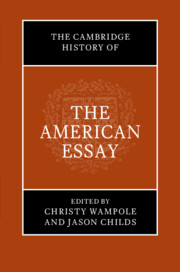Book contents
- The Cambridge History of the American Essay
- The Cambridge History of the American Essay
- Copyright page
- Contents
- Acknowledgments
- Notes on Contributors
- Introduction
- Part I The Emergence of the American Essay (1710–1865)
- Part II Voicing the American Experiment (1865–1945)
- 9 Writing Freedom before and after Emancipation
- 10 Social Justice and the American Essay
- 11 “Zones of Contention” in the Genteel Essay
- 12 The American Comic Essay
- 13 Nineteenth-Century American Travel Essays: Aesthetics, Modernity, and National Identity
- 14 American Pragmatism: An Essayistic Conception of Truth
- 15 The Essay in the Harlem Renaissance
- 16 The Southern Agrarians and the New Criticism
- 17 Subjective and Objective: Newspaper Columns
- 18 The Experience of Art: The Essay in Visual Culture
- 19 The Essay in American Music
- Part III Postwar Essays and Essayism (1945–2000)
- Part IV Toward the Contemporary American Essay (2000–2020)
- Recommendations for Further Reading
- Index
11 - “Zones of Contention” in the Genteel Essay
from Part II - Voicing the American Experiment (1865–1945)
Published online by Cambridge University Press: 28 March 2024
- The Cambridge History of the American Essay
- The Cambridge History of the American Essay
- Copyright page
- Contents
- Acknowledgments
- Notes on Contributors
- Introduction
- Part I The Emergence of the American Essay (1710–1865)
- Part II Voicing the American Experiment (1865–1945)
- 9 Writing Freedom before and after Emancipation
- 10 Social Justice and the American Essay
- 11 “Zones of Contention” in the Genteel Essay
- 12 The American Comic Essay
- 13 Nineteenth-Century American Travel Essays: Aesthetics, Modernity, and National Identity
- 14 American Pragmatism: An Essayistic Conception of Truth
- 15 The Essay in the Harlem Renaissance
- 16 The Southern Agrarians and the New Criticism
- 17 Subjective and Objective: Newspaper Columns
- 18 The Experience of Art: The Essay in Visual Culture
- 19 The Essay in American Music
- Part III Postwar Essays and Essayism (1945–2000)
- Part IV Toward the Contemporary American Essay (2000–2020)
- Recommendations for Further Reading
- Index
Summary
The genteel tradition, inspired by British essayists, thrived in the United States in the early twentieth century up until the 1930s. George Santayana coined the term in 1911 to describe a group of New England intellectuals who, through their essays, acted as cultural gatekeepers, defining the standards of moral behavior and the rules of good literature. This chapter traces a genealogy between European genteel essayists and their American counterparts, focusing particularly authors such as Charles S. Brooks, Katharine Fullerton Gerould, Louise Imogen Guiney, Gail Hamilton, Gertrude Bustill Mossell, Agnes Repplier, George William Curtis, Donald Grant Mitchell, and Charles Dudley Warner. Much of the genteel essayists’ privileged Anglo, upper-middle-class, Christian values and sought to defend "high culture" against its perceived enemies: industrialism, immigration, capitalism, and class polarization. The chapter closes with a presentation of Black genteel essayistic writing and reflects on how the genteel tradition should be understood today, as a more critical eye is turned toward writers of the past whose ideals do not align with contemporary social and political sensibilities.
Keywords
- Type
- Chapter
- Information
- The Cambridge History of the American Essay , pp. 182 - 196Publisher: Cambridge University PressPrint publication year: 2023

